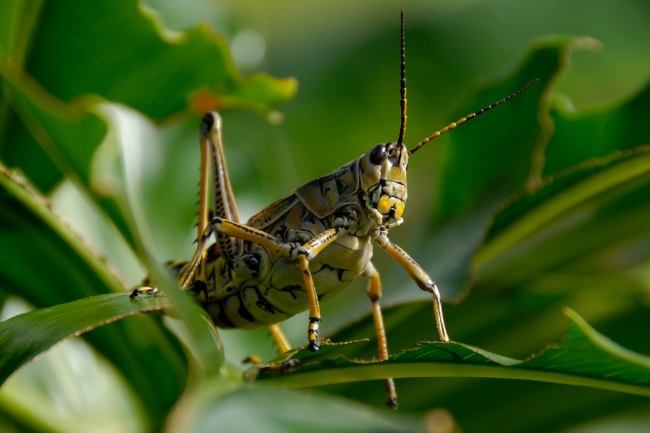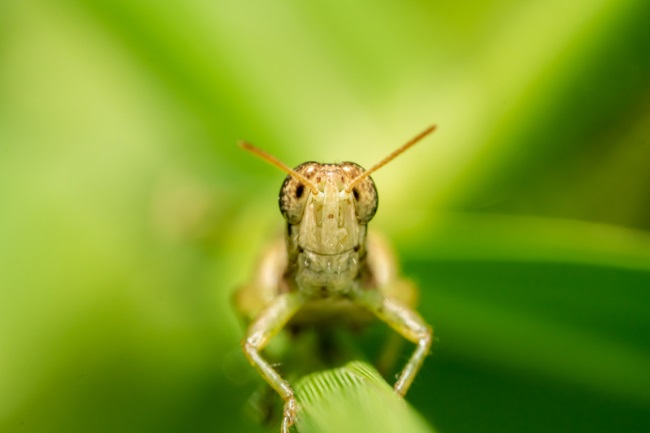Locusts are a type of grasshopper that undergoes morphological changes when high densities of the individuals occur. Locust swarms can reach plague proportions, damaging crops and causing economic loss to rural communities.
Contents
What is a locust?

The title locust is often overused. Locusts are grasshoppers; however, the name is generally only used for those grasshoppers that go from being solitary to being gregarious under certain external circumstances, meaning that they seek out each others company and swarm.
| Characteristic | Grasshoppers | Locusts |
|---|---|---|
| Behavior | Solitary | Gregarious |
| Grouping | Individuals or small groups | Large swarms |
| Coloration | Typically green or brown | Variable coloration, can include yellow, orange, or black patches |
| Body Size | Generally smaller | Can grow larger in size |
| Wings | Short wings | Longer wings |
| Flight Ability | Limited flying capabilities | Capable of sustained flight over long distances |
| Feeding Habits | Feed on vegetation individually | Form swarms and consume large amounts of vegetation |
| Reproduction | Lay eggs individually | Lay eggs in large clusters |
There are around 8,000 grasshopper species globally, and only a handful of those can be counted as locusts. Sometimes people use the term to refer to any large species of grasshopper or any species that appear in great numbers, yet true locusts undergo physical changes as well as changes in their behaviour.
Grasshoppers are generally solitary creatures, spending their days feeding on grass and other vegetation until they are ready to search out a mate. In the right habitat, with plenty of food, grasshoppers can be found in large numbers; however, these individuals are in the same place because there is plenty of available food, rather than because they are seeking each other out.

Locusts start life in the same way, busy eating and searching for food in a solitary fashion. The change occurs when specific climatic conditions occur. This usually means heavy rains, causing a sudden flush of vegetation, followed by a drought, causing vegetation to die back. The good conditions, with plentiful food, cause rapid breeding within the locust community, with their breeding rates evolved to increase when there is plenty to eat. The locusts spread out across the available food at this point, so even though there are higher numbers, this doesn’t cause any significant problems.
The real problem occurs when the boom turns bust, with arid conditions causing suitable food to decrease and feeding grounds to become restricted. When this happens, the density of locusts increases further, as they are forced into smaller areas of land. Once critically high densities occur, locusts begin to undergo morphological changes. It has been found that these changes are triggered by the individual locusts having their back legs touched a certain number of times by other members of their species. This usually takens place because each locust is nipping at it’s neighbour in an effort to get enough food.
The physical changes start with the release of serotonin. Without this hormone solitary locusts do not make the transformation to their gregarious state. They then begin to change morphologically, including visually obvious aspects such their colour turning from green to yellow, and their wings lengthening and becoming stronger.
They also start to swarm, migrating long distances in tightly packed groups, no longer solitary individuals, but suddenly a plague.
Also read: How do Grasshoppers Reproduce? (Eggs & Mating Explained)
A plague of locusts

For many people, plagues of locusts may only be familiar from the bible, yet for others they are a devastating fact of life. The most famous locust may be the desert locust, which is found throughout much of Africa and into Asia. Due to the climate of the area, the conditions needed to create locusts swarms can occur with relative regularity. Swarms can be most detrimental when several years of suitable conditions follow each other, meaning the communities affected are hit again and again.
| Species | Scientific Name | Habitat | Geographic Range |
|---|---|---|---|
| African Migratory Locust | Locusta migratoria | Grasslands, savannas, and agricultural areas | Sub-Saharan Africa, parts of Asia, and Europe |
| Australian Plague Locust | Chortoicetes terminifera | Grasslands, agricultural areas | Australia |
| Desert Locust | Schistocerca gregaria | Deserts, semi-arid regions | Africa, the Middle East, and parts of Asia |
| American Grasshopper | Schistocerca americana | Grasslands, meadows, and agricultural areas | North and Central America |
Locusts are not just found in Africa, with the migratory locust found right across to New Zealand and Australia. The Bombay locust, as the name suggests, is found in India and south-east Asia. Though North America has historically had two species of locust. One is extinct, the Rocky Mountain locust, though it used to form swarms several miles long in some years. The high plains locust is currently still around, however it has become so rare that it no longer swarms.
Locust swarms can travel many hundreds of miles searching for food. Once they have a suitable area to land the hungry mouths can eat away everything in sight, destroying valuable crops. Their hunger even drives them to become carnivores. However, they have only been recorded to eat dead animal carcasses and unfortunate insects. Swarms can become so dense that they appear like a cloud, darkening the sky and descending like rain.
Because of the economic damage they do, control of locusts is carried out in many areas where they occur. These controls largely involve the use of pesticides, though other methods, such as vehicles that gather up the locust and drown them, are also sometimes employed. A key control method is to destroy the locust’s eggs before they hatch, either through disturbing the soil in which they have been laid, or through use of pestcides. Modern technology is now adding to locusts management, picking up areas with conditions that will encourage the formation of swarms.
Also read: Do Grasshopper Eat Grass? Or Something Else?
Good grasshopper gone bad
There are no morphological differences to separate out grasshoppers from locusts; everything hinges on that key moment when they undergo their transformation. Locusts really are Jekyll and Hyde type of insect, behaving perfectly well most of the time until their button is pushed and all hell breaks loose. If it wasn’t for the damage they did to livelihoods, and often to the incomes of some of the most impoverished communities in the world, the natural spectacle would surely inspire awe rather than hate.
Locusts are valuable food for many animals, including birds, mammals, and other insects. Even humans eat locusts, considering them a great delicacy in many countries. One day technology may allow us to better manage swarms without the need to destroy them completely, and then we can marvel at the great clouds of insects swirling through the air above us without fear of the plague they represent.

